|
Annual
Report - 2015
REPORT OF THE NEW YORK STATE AVIAN RECORDS COMMITTEE
FOR 2015
The New York State Avian Records Committee (hereafter “NYSARC” or the “Committee”) reviewed 70 occurrences of review species involving 113 separate submissions from 2015 and seven occurrences from previous years involving seven submissions. Nine of the 70 occurrences in 2015, involving 16 submissions, were of potential first state records. Reports were received from 25 of the 62 counties plus the pelagic region. The number of reports accompanied by photographs, audio, and video remains high and, naturally, benefits the value of the archive. The Committee wishes to remind readers that reports submitted to listservs, local bird clubs, rare bird alerts (RBAs) and even The Kingbird Regional Editors are not necessarily passed along to NYSARC. Doing so, therefore, remains the responsibility of the observer(s). The growing use of the Internet and mobile phones, as well as eBird, has had a very positive impact on the timely dissemination of rare bird sightings and has made it easier for birders to locate rarities found by others. The Committee has always held that receipt of multiple independent reports provides a much fuller documentation of the sighting and can in some cases increase the likelihood of acceptance. We therefore urge ALL observers, not just the finder, to submit written reports and/or photographs. The names of the 92 contributors that submitted materials (written reports, photographs, audio, video, and sketches) are listed alongside accepted reports and again at the end of this document. Where possible, the name(s) of the original finder(s) is (are) included in the narratives. Production of this Annual Report is a team effort. In addition to the contributors referenced above, several Kingbird Regional Editors have helped observers to prepare and submit documentation. A special thanks goes to Mike Morgante (Region 1 Editor) for forwarding important documentation.
HOW TO SUBMIT REPORTS
Advice on how to prepare and submit a report is provided on the NYSARC pages within the NYSOA web site: https://nybirds.org/NYSARC/index.htm. Here, a list of species requested for review by NYSARC (The Review List) is provided along with illustrated copies of previous annual reports. The Committee is very grateful to Carena Pooth (NYSOA Web Master) for updating and continuously improving the NYSARC web site. An on-line reporting form allows observers to compose a written report and attach up to five digital image files. Documentation (written reports and photographs) and any other correspondence for the Committee can also be sent via email to NYSARC secretary, Gary Chapin, at:
. As a last resort, you can also use regular mail to get your report to Gary:
Gary Chapin
125 Pine Springs Drive
Ticonderoga, NY 12883
E-mail:
HIGHLIGHTS
It seems almost inconceivable, but for the second consecutive year, four new species were added to the Checklist of the Birds of New York State: Little Egret (Egretta garzetta), Crested Caracara (Caracara cheriway), Pacific-slope Flycatcher (Empidonax difficilis), and Bronzed Cowbird (Molothrus aeneus). As of the end of 2015, this brings the State list up to 493 species. [Note: subsequent to 2015, additions of Garganey (Spatula querquedula) and Clark’s Grebe (Aechmophorus occidentalis), as well as the 2017 demotion of Thayer’s Gull (Larus glaucoides thayeri) to subspecific status, elevates the State list currently to 494, with NYSARC still to vote on other potential additions.] Although not a new species, New York’s first record of “Harlan’s” Red-tailed Hawk (Buteo jamaicensis harlani) was found in 2003 but only recently identified. A year after the first record, we added the second Fea’s Petrel (Pterodroma feae), and two years after the first Neotropic Cormorant (Phalacrocorax brasilianus), we added three more records. A few other highlights were an inland Clapper Rail (Rallus crepitans), a very famous Painted Bunting (Passerina ciris), and a large influx of Franklin’s Gulls (Leucophaeus pipixcan).
COMMITTEE NEWS
The 2015 annual meeting was held via Skype on 23 Sep 2018. As with the 2014
annual meeting, this meeting was held only six months after the previous one, as
we continue to make progress on our backlog, essentially completing one year
of records review in half the time. Note that the annual meeting year refers to the
latest reports reviewed at that meeting. For example, at the 2015 annual meeting
we mainly reviewed reports of birds seen in 2015, along with a few reports from
earlier years. During the annual meeting we discussed or completed the voting
for some 20 or so records. We also decided to review prior Mew Gull (Larus
canus) records in the State and vote on the subspecies. In the past the Committee
has, for the most part, voted only on the species and ignored the subspecies, but
since the Mew Gull subspecies are fairly well differentiated, the Committee
decided that this would be a worthwhile task. The Committee discussed some of
the procedures that will be needed in order to incorporate review of eBird
records, and we are moving closer to that goal. Changes to the review list were
discussed, and it was decided that none were needed at this time. The terms of
Andy Guthrie, Doug Gochfeld and Derek Rogers expired at the end of 2018.
Doug and Derek agreed to continue on the Committee, and both accepted
another three-year term. After many years of service, Andy Guthrie opted to step
down and give someone else an opportunity. Andy has been a stalwart on the Committee since 2005. His take on difficult reviews has been extremely
practical, well thought out, and his arguments very persuasive. This same
mindset has been brought to bear on all other Committee matters as well. In
short, Andy has been an invaluable member of NYSARC, and we will miss him.
Jay McGowan has big shoes to fill, but he was the clear choice of the Committee
to replace Andy, and we are pleased that Jay has accepted and that he has been
approved by the NYSOA Board. As of this writing (Mar 2019), Jay is already
fully involved in Committee activities.
NOTE: In the reports accepted, listed below, the range of dates for a record may
not be known based only on the submitted material. Accepted eBird reports may
extend the known range of dates and if the NYSARC also finds these reports
acceptable, the eBird range of dates are listed along with the NYSARC record
submission.
2015 Reports Accepted
Black-bellied Whistling-Duck (Dendrocygna autumnalis)
2015-27-A One, Wilson Tuscarora State Park, Niagara, 3 Jun (Christopher Kundl, ph C. Kundl). eBird 2 Jun-19 Jul
2015-38-A/B Two, Nickerson Beach, Nassau, 21 Jul (Brent Bomkamp, Pat Palladino, ph B. Bomkamp)
A local photographer, Charlie Horton, was at one of his most frequently watched patches, the mouth of Twelve Mile Creek in Wilson-Tuscarora State Park, when he discovered this Black-bellied Whistling-Duck on 28 May. Although the word did not get out to birders until 2 Jun, the bird stuck around for several weeks, allowing almost everyone who desired to a chance to go and see it. The late Chris Kundl documented the record for NYSARC. The two birds at Nickerson Beach were discovered by a park employee and were only seen on the one day, 21 Jul.
Pink-footed Goose (Anser brachyrhynchus)
2015-1-A/B One, Riverhead Sod Farms, Suffolk, 3, 11 Jan (Angus Wilson, Willie D’Anna, ph John Shemilt, W. D’Anna). eBird 1 Jan-28 Feb
The large flocks of Canada Geese (A. canadensis) in the Riverhead area of Eastern Long Island continue to attract one or more Pink-footed Geese most winters. This bird stayed around at least two months. A sighting in the area on 9 Nov 2014 (eBird) could have been the same individual, but it would seem unusual that it could escape detection until the following New Year’s Day.
Western Grebe (Aechmophorus occidentalis)
2015-61-A/B One, Oswego, Oswego, 16 Dec (Kevin McGann, Bill Purcell, ph
K. McGann, B. Purcell). eBird 16, 17, 20 Dec
This Western Grebe at Oswego Harbor was discovered by Gregg Dashnau on 16 Dec and was seen by a small group of birders during its brief stay in the area.
White-winged Dove (Zenaida asiatica)
2015-58-A One, Pelham Bay Park, Bronx, 23 Nov (Richard Aracil, ph R. Aracil)
Richard Aracil found and documented this record for NYSARC. Like many others of this species in the State, this individual did not linger beyond the day of its discovery. This appears to represent the first record for the Bronx.
Rufous Hummingbird (Selasphorus rufus)
2015-42-A/B One, Fort Jackson, St. Lawrence, 23 Jul (Nick Leone, Eileen Wheeler, ph E. Wheeler)
Eileen Cardinal found this adult male Rufous Hummingbird at her feeding station on 22 Jul, and she contacted Jeff Bolsinger, who in turn contacted Nick Leone and Eileen Wheeler. Leone and Wheeler were able to see the bird the following day, and they documented the sighting for NYSARC. The bird was only seen on those two days.
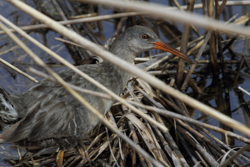 Clapper Rail
photo
© Steve M. Chorvas
Clapper Rail
photo
© Steve M. Chorvas
(click photo to enlarge)
Clapper Rail (Rallus crepitans)
2015-32-A One, Great Vly WMA, Ulster, 26 Apr (Steve M. Chorvas, ph S. Chorvas). eBird 26, 28 Apr
This record represents a very rare sighting of an inland Clapper Rail in New York and at a site where a King Rail (R. elegans) had been documented only two years prior (D’Anna et al. 2017b). It provided excellent views alongside a much smaller Virginia Rail (R. limicola). It was not reported after 28 Apr.
Ruff (Calidris pugnax)
2015-23-A One, Staten Island, Richmond, 16-17 May (David Eib, ph D. Eib) This female/faeder male Ruff was discovered by David Eib, Seth Wollney and Maya Shikhman and provided what is believed to be the first record for Staten Island. The bird stayed for just two days.
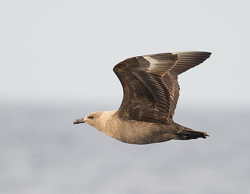 South Polar Skua
photo
© Sean Sime
South Polar Skua
photo
© Sean Sime
(click photo to enlarge)
South Polar Skua (Stercorarius maccormicki)
2015-31-A/B Three, Southwest of Hudson Canyon, Pelagic, 1 Jun (Sean Sime, Doug Gochfeld, ph S. Sime, D. Gochfeld)
2015-35-A One, Pelagic waters of Suffolk County, Pelagic, 1 Jun (Doug Gochfeld, ph D. Gochfeld)
Certainly, one of the highlights of the See Life Paulagics pelagic trip out of Brooklyn on 1 Jun was these four South Polar Skuas. Three were seen together (2015-31) and the fourth (2015-35) was found in much shallower water.
Long-tailed Jaeger (Stercorarius longicaudus)
2015-33-A/B One, Breezy Point, Queens, 18 Jun (Doug Gochfeld, Sean Sime) Near the end of a long seawatch, this adult Long-tailed Jaeger came into view from the east and flew westerly past Doug Gochfeld and Sean Sime. They studied it carefully in their scopes, and although photos of this distant bird were attempted, the observers were stymied in that effort. Nevertheless, the Committee was convinced by the two thorough reports provided by these very experienced seawatchers.
Common Murre (Uria aalge)
2015-2-A One, Jones Beach, Nassau, 11 Jan (Seth Ausubel)
Seth Ausubel discovered this Common Murre in basic plumage at Jones Beach State Park and watched it until it drifted far to the east of him. Only a few other birders were able to see the murre that morning.
Thick-billed Murre (Uria lomvia)
2015-6-A One, Montauk, Suffolk, 20, 21 Jan (Michael S. Scheibel, ph M. Scheibel). eBird 20-23 Jan
2015-9-A One, Coney Island, Kings, 12 Feb (Shane Blodgett, ph S. Blodgett) Michael Scheibel discovered the basic plumaged Thick-billed Murre at Lake Montauk inlet. The bird stayed in the area for a few days, allowing a handful of other birders to see it. The Coney Island bird was found by Shane Blodgett and was only observed by a couple of other birders, not being found on subsequent days.
Sabine’s Gull (Xema sabini)
2015-34-A/B One, Breezy Point, Queens, 18 Jun (Doug Gochfeld, Sean Sime, ph D. Gochfeld, S. Sime)
2015-57-A One, East Quogue, Suffolk, 22 Nov (Seth Ausubel)
While spending several hours at Breezy Point, conducting a productive seawatch and studying the birds attracted to the tern colony, Gochfeld and Sime found a molting Sabine’s Gull resting on the beach. This appears to be just the second record for New York City, with the only prior record occurring 14 Oct 1926 in Brooklyn (Bull 1964). The bird in East Quogue was found by Seth Ausubel and watched as it flew past over the ocean. It was an adult in basic plumage.
Franklin’s Gull (Leucophaeus pipixcan)
2015-21-A One, Rochester, Monroe, 7 May (Ethan Gyllenhaal)
2015-53-A/C One, Venetian Shores Park, Suffolk, 13 Nov (Peter Morris, Brent Bomkamp, Seymour (Sy) Schiff/Joseph Giunta, ph P. Morris, S. Schiff)
2015-54-A Six, Derby Hill, Oswego, 13 Nov (Bill Purcell). eBird 13-14 Nov 2015-67-A Two, Captree State Park, Suffolk, 13 Nov (Seymour (Sy) Schiff/Joseph Giunta, ph S. Schiff)
2015-68-A One, Point Lookout, Nassau, 13 Nov (Seymour (Sy) Schiff/Joseph Giunta, ph S. Schiff)
2015-69-A Two, Robert Moses State Park, Suffolk, 13 Nov (Pat Palladino, ph
P. Palladino)
Franklin’s Gull is nearly annual in New York State, especially along the Niagara River, and, as a result, NYSARC will no longer review upstate reports after 2017. Elsewhere, however, it remains a very rare species. In some years during the fall migration, numbers of Franklin’s Gulls may be pushed eastward by westerly winds associated with strong cold fronts. 2015 was such a year, and the result was a spectacular incursion of this species, not only in New York, but along the entire eastern seaboard from Florida to New Brunswick and Quebec, Canada. The five fall records that were documented for NYSARC include four from coastal locations and one from Lake Ontario, with the maximum number seen at one site being six individuals. A quick check of the eBird species map for Franklin’s Gull (Mar 2019) shows about a dozen locations with Franklin’s Gulls in the western half of the State during 2015, about 20 sites in the coastal region, and one more site near Glens Falls in Warren County. Almost all of the Franklin’s Gulls seen in New York were discovered on 13 Nov and most were one-day wonders. Franklin’s Gull is much rarer in the spring, when Ethan Gyllenhaal and Greg Lawrence found an adult along the shore of Lake Ontario in Rochester on 7 May (2015-21).
during
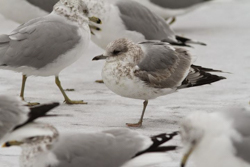 Mew Gull
photo
© Shane Blodgett
Mew Gull
photo
© Shane Blodgett
(click photo to enlarge)
Mew Gull (Larus canus brachyrhynchus)
2015-8-A One, Brooklyn, Kings, 9 Feb (Shane Blodgett, ph S. Blodgett)
Shane Blodgett is a shining example of how one can become good at finding rare gulls, combining knowledge, skill and patience. Scanning through the mass of Ring-billed Gulls at the Veteran’s Memorial Pier in Brooklyn, Blodgett found this Mew Gull of the North American race, believed to be in its second cycle. This bird was apparently not reported after this day. Another Mew Gull, this being a first-cycle individual, was also present in the Brooklyn area during the same winter (eBird Feb 2019) but was not documented for NYSARC.
Arctic Tern (Sterna paradisaea)
2015-28-A One, Nickerson Beach, Nassau, 10 Jun (John H. Haas, ph J. Haas) 2015-29-A One, Nickerson Beach, Nassau, 8 Jun (Joseph Viglietta, ph J. Viglietta). eBird 9 Jun
Two different Arctic Terns were found at Nickerson Beach within two days of each other. Viglietta documented an adult and Hass documented a first-cycle individual. The flats at Moriches Inlet, much further east on Long Island, are known for attracting this species every year in late spring/early summer. However, there are relatively few records from further west, though we might expect more appearing at tern colonies as birders become accustomed to looking for the fine details necessary to pick them out from the abundant Common Tern (S. hirundo).
White-faced Storm-Petrel (Pelagodroma marina)
2015-41-A One, Block Canyon N 40°01.363', W 71°21.292', Pelagic, 21 Aug (John Shemilt, ph J. Shemilt)
The Committee is grateful to John Shemilt for documenting yet another White- faced Storm-Petrel in the pelagic waters off New York. The work of Shemilt and Paul Guris/See Life Paulagics has greatly increased our understanding of bird life in the pelagic zone. Due in large part to their efforts, it now seems that this species may be a regular visitor in late summer to our waters.
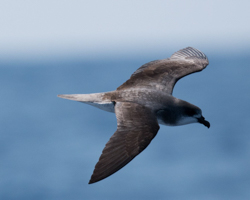 Fea's Petrel
photo
© John Shemilt
Fea's Petrel
photo
© John Shemilt
(click photo to enlarge)
Fea’s Petrel (Pterodroma feae)
2015-40-A One, 76 nm SSE of Shinnecock, Pelagic, 18 Aug (John Shemilt, ph
J. Shemilt)
Providing the second record within a year, as well as just the second fully- accepted record in New York, this Fea’s Petrel was found in pelagic waters and nicely photo-documented by John Shemilt. See Wilson et al. (2016) for a thorough discussion of the considerations involved in accepting records of this species.
Neotropic Cormorant (Phalacrocorax brasilianus)
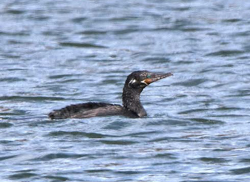 Neotropic Cormorant
Neotropic Cormorant
with Semipalmated Plover
photo
© James Pawlicki
(click photo to enlarge)
2015-14-A/D One, Pomfret/Fredonia, Chautauqua, 23, 25 Apr (Kayo J. Roy, Willie D’Anna, James Pawlicki, ph W. D’Anna, J. Pawlicki). eBird 23-25 Apr 2015-39-A/B One, Buffalo, Erie, 15 Jul (James Pawlicki, Gates Dupont, ph J. Pawlicki, G. Dupont)
2015-70-A One, Motor Island WMA, Erie, 13 May (Ryan Bakelaar, ph R. Bakelaar)
All three records of Neotropic Cormorant this year came from the western edge of the State. While driving on the New York State Thruway near Fredonia, Jim Pawlicki noticed a much smaller cormorant flying along the Thruway with Double-crested Cormorants (P. auritus). Pulling over, he watched the bird fly nearly directly overhead, confirming its small size, as well as its shape, and noting a small bit of white on the throat near the base of the bill. Getting back into his vehicle and driving past the flock of cormorants, Pawlicki again pulled over and obtained a helpful cell phone image that shows the bird’s substantially smaller size. Pawlicki spread the word immediately to birders, and a few hours later Gale VerHague relocated the Neotropic Cormorant at Lake Erie State Park. Subsequently, the bird was found at a private pond in the Town of Pomfret, where it was seen by several birders over the course of the next couple of days. The Motor Island Neotropic Cormorant was a specimen that was collected at the Double-crested Cormorant colony on the island and documented by Department of Environmental Conservation technician, Ryan Bakelaar. On 13 Jul Pawlicki and Dean DiTommaso were studying a distant small cormorant at Buffalo Harbor, which they considered could be a Neotropic Cormorant, but the great distance did not allow them to rule out the possibility of a runt Double-crested Cormorant nor a hybrid. Two days later, following up on this sighting, Pawlicki and Gates Dupont located what appeared to be a different bird but one which they could confirm was a Neotropic Cormorant. Unlike the bird that Pawlicki and DiTommaso observed, which appeared to be an adult, this bird was an immature. Using cell phones, Pawlicki was able to direct Dupont, who was in a kayak, to the spot where he could see the Neotropic Cormorant on the breakwall. Dupont was able to obtain some soft video to help document the record. Prior to these three records, the only record in the State was from Hamlin Beach State Park in 2013 (Wilson et al. 2016).
American White Pelican (Pelecanus erythrorhynchos)
2015-55-A One, Jamaica Bay Wildlife Refuge, Queens, 14 Nov (Marianne Ofenloch, ph M. Ofenloch). eBird 14 Nov-20 Dec
Marianne Ofenloch and Regina Volz discovered this American White Pelican flying over the west pond at Jamaica Bay Wildlife Refuge. eBird reports indicated that up to two birds were seen at the refuge after this date. Due to an increase in reports in recent years, NYSARC is no longer requesting documentation for this distinctive species.
Little Egret (Egretta garzetta)
2015-22-A/C One, Thorne Preserve/Gardiner County Park, Suffolk, 20-21 May (Derek Rogers, Pete Morris, Michael S. Scheibel, ph D. Rogers, P. Morris, M. Scheibel)
This Little Egret, the first in New York, was discovered by Pete Morris at Gardiner County Park. See Morris (2015) and D’Anna et al. (2017a) for a full account of this record.
White Ibis (Eudocimus albus)
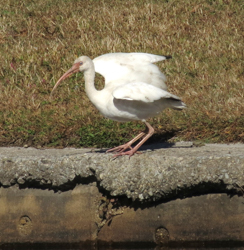 White Ibis
photo
© Pamela Langford
White Ibis
photo
© Pamela Langford
(click photo to enlarge)
2015-44-A/C One, Prospect Park/Greenwood Cemetery, Kings, 11-12 Oct (Klemens Gasser, Ryan Morrissey, Pamela Langford, ph K. Gasser, R. Morrissey, P. Langford)
2015-48-A/B One, Staten Island, Richmond, 18 Oct (Arie Gilbert, Catherine Barron, ph A. Gilbert)
The subadult White Ibis in Brooklyn was first observed by Klemens Gasser as it flew overhead at Prospect Park, then was seen on the ground the next day at nearby Green-Wood Cemetery. A week later another subadult was found at River Road on Staten Island but was only observed the one day. Although the two ibises were similar, the Committee felt that the primary molt pattern differentiated them, and thus, they were kept as two records.
White-faced Ibis (Plegadis chihi)
2015-49-A One, Captree Island, Suffolk, 18 Jun (Arie Gilbert). eBird 18 Jun-14 Jul
This alternate-plumaged adult White-faced Ibis was discovered by Arie Gilbert and Phil Uruburu and stayed in the area for nearly a month.
Mississippi Kite (Ictinia mississippiensis)
2015-24-A/B One, Sterling Forest, Orange, 16 May (Pete Morris, Taylor Sturm)
2015-25-A One, Highland Mills, Orange, 26 May (Tom Brown)
Pete Morris, Taylor Sturm, Tim Dunn, and John Gluth had a relatively brief view of a flying adult Mississippi Kite at Sterling Forest. Although they did not have time to obtain a photo, they studied the bird carefully to confirm the identification. The bird was apparently observed later that day by the Queens County Bird Club but was not seen on subsequent days. Although it was a life- bird for him, Morris noted in his report that the species was “firmly on my radar” for the day, as a number of birds had been reported recently and the southerly airflow and warm temperatures they were experiencing he knew to be conducive to bringing these raptors north into the region. The Highland Mills kite was observed by a very experienced birder at a family gathering; the detailed description indicated that this was a subadult bird.
Crested Caracara (Caracara cheriway)
2015-4-A/B One, Bear Mountain State Park, Rockland, 5 Jan (Edwin McGowan, Gerhard Patsch)
2015-12-A One, Montgomery, Orange, 10-14 Apr (Kenneth M. McDermott, ph Mary Buskey, Matt Zeitler, Peter Schuyler, Jess Deitz). eBird 10-16 Apr
2015-66-A One, Seaford, Nassau, 10 Jan (Steve Schellenger, ph Charles Sammut)
These three records of Caracara constitute the first and only records for New York. For a detailed account of all three records, see D’Anna et al. (2017a).
Gyrfalcon (Falco rusticolus)
2015-7-A/B One, Town of Shawangunk, Ulster 5, 7, 8, 10, 12, 13, 15-18 Feb (Eamon Freiburger, Kenneth M. McDermott, ph E. Freiburger) & Town of Montgomery, Orange, 20, 22 Feb (Kenneth M. McDermott, ph Drew Schuyler) 2015-65-A One, Town of Shawangunk, Ulster, 25 Dec (Kenneth M. McDermott)
Eamon Freiburger discovered the white-morph Gyrfalcon in Ulster County, where it was seen by numerous birders over the following two weeks. The bird moved to Orange County on 20 Feb, where Ken McDermott and Drew Schuyler were able to document it. The following winter, McDermott documented what appeared to be the same bird, this time back in Ulster County (2015-65).
Ash-throated Flycatcher (Myiarchus cinerascens)
2015-64-A One, Montauk, Suffolk, 19 Dec 2015- 1 Jan 2016 (Brent Bomkamp) This Ash-throated Flycatcher was discovered by John Gluth during the Montauk CBC and seen by several CBC participants that day. The bird lingered at the site until the last report, by Brent Bomkamp, on 1 Jan 2016.
Pacific-slope Flycatcher (Empidonax difficilis)
2015-56-A/D One, Central Park, New York, 18, 21, 22 Nov (Peter Paul, Jack Rothman, Ardith Bondi, Richard Guthrie, ph Robert Rovulo, A. Bondi, R. Guthrie, video Tim Healy, audio P. Paul)
This Pacific-slope Flycatcher at Central Park constitutes the first record for New York. See D’Anna et al. (2017a) for a full account.
Say’s Phoebe (Sayornis saya)
2015-18-A One, Conewango Swamp WMA, Cattaraugus, 12 Apr (Willie D’Anna, ph W. D’Anna)
While working on the “April Bird Count” for the Buffalo Ornithological Society, Joe Mitchell found this Say’s Phoebe at Conewango Swamp WMA. Joe alerted other birders immediately, and several were able to travel to see the bird that day. Most records of Say’s Phoebe in the East are in the fall and winter (Burke 1998). This is only the second spring record in New York, the first being on 26 Apr 2013 in Brooklyn.
Cave Swallow (Petrochelidon fulva)
2015-63-A Two, Pelham Bay Park, Bronx, 14-15 Nov (Richard Aracil)
Richard Aracil and Matthieu Benoit discovered these Cave Swallows, and Aracil managed to get diagnostic photos of one bird on 14 Nov. Although Aracil only reported two Cave Swallows as being definitively identified over the two- day period, he indicated that five other swallows that were not observed as well were also likely this species.
Townsend’s Solitaire (Myadestes townsendi)
2015-47-A/I One, John Boyd Thacher State Park, Voorheesville, Albany, 20-26 Oct (Thomas Williams, John Kent, Richard Guthrie, Jeremy Collison, Susan Joseph, Terry Bain, Arie Gilbert, Gregg Recer, Bill Purcell, ph T. Williams, J. Kent, R. Guthrie, J. Collison, A. Gilbert, G. Recer, B. Purcell). eBird 20 Oct-8 Nov
This Townsend’s Solitaire at John Boyd Thacher State Park was well- documented subsequent to its discovery by Craig Thompson and Ro Woodard.
Varied Thrush (Ixoreus naevius)
2015-10-A One, Great River, Suffolk, 13-21 Mar (Kathaleen Rogers, ph K. Rogers)
Kathaleen Rogers documented this adult male Varied Thrush that visited her feeding station for nine days.
Lark Sparrow (Chondestes grammacus)
2015-36-A/E One, Wilton, Saratoga, 5 Jul (John Kent, Thomas Williams, Will Raup, Susan Beaudoin, David W. Harrison, ph J. Kent, Naomi Lloyd). eBird 2-7 Jul
Brendan Hathaway found this Lark Sparrow on 2 Jul at the Wilton Wildlife Preserve, and several birders were able to see it and document it over the following days.
Harris’s Sparrow (Zonotrichia querula)
2015-52-A One, Loudonville, Albany, 14 Nov (Jeremy Collison, ph J. Collison). eBird 11-29 Nov
Pastor John Paarlberg discovered this adult Harris’s Sparrow at his feeding station, and Richard Guthrie arranged access to the yard for birders. As a token of appreciation, several birders brought food items to donate to the local church’s food pantry, a positive result for both birders and community residents.
Bronzed Cowbird (Molothrus aeneus)
2015-51-A One, Norfolk, St. Lawrence, 16-28 Oct (Nora Lee, ph N. Lee)
This constitutes the first and only record of Bronzed Cowbird to date in New York. For a full account, see D’Anna et al. (2017a).
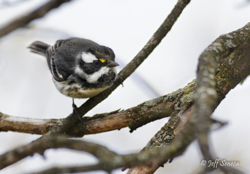
Black-throated Gray Warbler
photo
© Jeff Seneca
(click photo to enlarge)
Black-throated Gray Warbler (Setophaga nigrescens)
2015-13-A One, Hawthorne, Westchester, 23 Apr (Jeff Seneca, ph J. Seneca) Birding by himself at the Gate of Heaven Cemetery, Jeff Seneca found and photographed what turned out to be his life Black-throated Gray Warbler. There are now about 18 records in New York, with those about equally split between downstate and upstate.
Western Tanager (Piranga ludoviciana)
2015-5-A One, Rocky Point, Suffolk, 28-30 Jan (Sean Keenan, ph S. Keenan)
2015-20-A One, Prospect Park, Brooklyn, Kings, 12 May (Shane Blodgett, ph
S. Blodgett)
The adult female Western Tanager at Rocky Point showed up at the feeding station of Sean Keenan and lingered for three days before departing. Another female was found in Prospect Park by Rob Jett and documented for NYSARC by Shane Blodgett.
Blue Grosbeak (Passerina caerulea)
2015-26-A/B Two, Dover Plains, Dutchess, 27 May (Barbara Mansell, Susan Joseph)
A “pair” of Blue Grosbeaks was found by these observers at Dover Plains. With the reports lacking photos, the Committee was at first skeptical of this record. However, considering that these experienced birders also saw and recorded the similar but smaller and more expected Indigo Bunting (P. cyanea) at the same location, Committee members were led to accept the record.
Painted Bunting (Passerina ciris)
2015-19-A One, Robert Moses State Park, Suffolk, 8 May (Jason Natti, video Nicole Natti)
2015-60-A/E One, Prospect Park, Kings, 29 Nov-2 Jan 2016 (Richard Guthrie, Paul Chung, Debra Van Enkenvoort, Sean Sime, Kenneth M. McDermott, ph R. Guthrie, P. Chung, S. Sime, Curt McDermott). eBird 29 Nov-3 Jan 2016
Jason and Nicole Natti discovered and obtained video evidence of the adult male Painted Bunting at the Coast Guard station in Robert Moses State Park. Unfortunately, since this was a gated community, it did not allow for other birders to see this striking bird. On the other hand, the well-documented adult male at Prospect Park was seen by hundreds, if not thousands, of observers, and featured prominently in newspaper and other media outlets. For discovering this stunning bird, Keir Randall receiving adulation from countless birders and casual observers alike. It was less certain that the bunting felt similarly toward Randall, though it did not appear to openly resent its new-found celebrity, as it lingered for nearly five weeks.
2015 Report Accepted
But Origins Unknown or Unnatural
European Greenfinch (Chloris chloris)
2015-15-A One, Saugerties, Ulster, 2 May (Robert Michaud, ph R. Michaud) This bird was observed at the feeding station of Robert Michaud, where a good photo of the bird was obtained. The Committee was in complete agreement that the photo showed a European Greenfinch. Although the photo indicated no obvious signs of captivity, the Committee felt that it was unlikely to be of natural origin. There are no accepted records of this species in North America, though there are several of birds believed to be escapes or releases [see, for example, Wilson et al. (2012) and Wilson et al. (2013)]. The species is only partially migratory in its native European range and is considered a short- distance migrant, at best (Wilson et al. 2012). Thus, it is not considered to be a very likely candidate for vagrancy to North America.
2013 Reports Accepted
Barnacle Goose (Branta leucopsis)
2013-93-A One, Sheldrake Lake, Larchmont, Westchester, 26 Feb (Andrew Baksh, ph A. Baksh). eBird 16 Feb-24 Mar
This record was documented for NYSARC by Andrew Baksh. One eBird report indicated that the goose was found on 15 Feb, but the person who discovered the bird was not indicated in any of the reports. Another, or possibly the same, Barnacle Goose was at Van Cortlandt Park in the Bronx from late November into the first week of January 2013 (2012-95). The NYSARC removed Barnacle Goose from its downstate review list in 2017.
Gyrfalcon (Falco rusticolus)
2013-94-A One, Gilgo Beach, Suffolk, 17 Feb (Andrew Baksh, ph A. Baksh). eBird 17 Feb-9 Mar
Andrew Baksh documented this exciting gray-morph Gyrfalcon for NYSARC and included two diagnostic images, one of the bird in flight. The Gyr had been found earlier in the day by Pat Lindsay.
2012 Report Accepted
Barnacle Goose (Branta leucopsis)
2012-95-D One, Van Cortlandt Park, Bronx, 5 Jan 2013 (Andrew Baksh, ph A. Baksh). eBird 25 Nov 2012-6 Jan 2013
This report documented a previously accepted record of a Barnacle Goose at this location.
2011 Report Accepted
White Ibis (Eudocimus albus)
2011-156-A Two, Jamaica Bay Wildlife Refuge, Queens, 10 Aug (Shane Blodgett, ph S. Blodgett)
Shane Blodgett discovered these two immature White Ibis early in the morning at Jamaica Bay Wildlife Refuge. Unfortunately, the birds did not linger, and only a couple of other birders managed to see them before they took flight. This now makes an incredible five records of White Ibis in New York in 2011, although it is conceivable that two of those pertain to the same individual (Wilson et al. 2013). Records of this species in the State have increased markedly since 2008.
2003 Report Accepted
“Harlan’s” Red-tailed Hawk (Buteo jamaicensis harlani)
2003-93-A One, Braddock Bay, Monroe, 1 May (Daena Ford, ph John Newhouse)
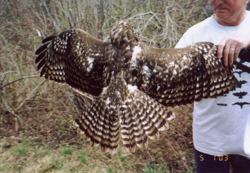 "Harlan's" Red-tailed Hawk
photo
© John Newhouse
"Harlan's" Red-tailed Hawk
photo
© John Newhouse
(click photo to enlarge)
The Committee is indebted to Daena Ford, co-director of Braddock Bay Raptor Research, for submitting the excellent documentation for this record, and also to Jerry Liguori, who first identified the bird. The record involves what was at first thought to be a dark-morph Red-tailed Hawk that was captured and banded at Braddock Bay by John Newhouse. In October of 2013, Luke Tiller, a former official raptor counter at the Braddock Bay Hawkwatch, wrote a blog post about dark buteos occurring at Braddock Bay, with photos. In July of 2014, raptor expert, Jerry Liguori, after having noticed the post, informed Luke that the individual of this record was actually a “Harlan’s” Hawk, a different subspecies of Red-tailed Hawk. “Harlan’s”
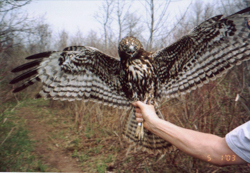 "Harlan's" Red-tailed Hawk
photo
© John Newhouse
"Harlan's" Red-tailed Hawk
photo
© John Newhouse
(click photo to enlarge)
Hawks breed in Alaska and the Northwest Territories of Canada and winter from British Columbia to the southern Great Plains and Texas (Liguori 2005). In September of 2014, Liguori followed up with his own blog post about this bird, indicating why this individual was a “Harlan’s” Hawk and not another form of Red-tailed Hawk. Ford compiled expert commentary on this bird from Liguori, Frank Nicoletti, and William Clark. All three experts explained why they were convinced that this was a “Harlan’s” Hawk. The record was unanimously accepted by the Committee, and this is believed to be the first photo-documented record of this form in New York (Dodge and Nicoletti 1998). There are no previous records accepted by NYSARC and, also, none in eBird for New York. Nevertheless, this form has been reported previously at hawk-watches in the State, and some of these may be valid.
1985 Report Accepted
Wood Stork (Mycteria americana)
1985-48-A One, Brewster, Putnam, 27 Aug (John Askildsen)
This old record of a Wood Stork in Putnam County was documented with a solid description by John Askildsen. Askildsen’s report indicates that the bird was originally found by a non-birder, Ted Gass, on 23 Aug but that birders were not made aware of it until 27 Aug. Unfortunately, it was found dead the next day. Photos of the bird were reportedly obtained, and the specimen was collected. However, the Committee’s attempts to locate this hard documentation, in order to further strengthen the record, were in vain. This record is mentioned in The Kingbird (Treacy 1985). If any readers have additional information on the whereabouts of the photos or specimen, the Committee would appreciate hearing about it.
2015 Reports Not Accepted
Cinnamon Teal (Spatula cyanoptera)
2015-50-A One, Montezuma NWR, Seneca, 2 Nov
This report documented a surprising bird seen along the Montezuma NWR wildlife drive. Originally found by James Osborn on 1 Nov, the bird stayed around for several days, allowing for much study and many photographs. It was originally considered to be a Cinnamon Teal in transitional plumage, as documented in this report, but with better views and photographs, it was then thought to be a hybrid Blue-winged (S. discors) x Cinnamon Teal. This duck was quite similar to a male Cinnamon Teal with its reddish plumage and a bill that was slightly larger and more spatulate than on a Blue-winged Teal. While the reddish plumage was not as warm and saturated in color as a basic plumaged adult male, some thought this could be explained by the bird being in “eclipse” plumage. However, other traits suggesting one parent being a Blue-winged Teal included a slightly paler area at the base of the bill, a slightly paler “hip” patch, and black spotting on the flanks. After some discussion about this report at the annual meeting, the Committee was unanimous in its agreement that the bird was most likely a hybrid. This is not the first such hybrid believed to be seen in New York. Sherony (1998) and Bull (1974) list a total of five occurrences.
“Eurasian” Green-winged Teal (Anas crecca crecca) 2015-3-A One, Hempstead, Nassau, 17 Jan
This report documented a male Green-winged Teal that appeared to lack a vertical white bar at the side of the breast. The observer concluded from this that the duck was not the expected American form, A. c. carolinensis, but must be of the Eurasian subspecies, A. c. crecca. While the Committee agrees that the lack of the vertical white bar on this bird is somewhat unusual, it does not, in and of itself, mean that it must be of the Eurasian subspecies. The photos that were included with the report were somewhat underexposed, making it difficult to firmly assess the subspecies. However, the stronger pale markings on the head that crecca shows are not apparent in the photos, nor is the horizontal stripe on the lower scapulars. As a result, the Committee was not convinced that this was a “Eurasian” Green-winged Teal.
“Selasphorus” Hummingbird (Selasphorus species) 2015-43-A One, Wappinger Falls, Dutchess, 9 Aug
This was a second-hand report of a bird that was identified as belonging to the Selasphorus hummingbird genus, which, in North America, includes Rufous (S. rufus), Allen’s (S. sasin) and Broad-tailed (S. platycercus) Hummingbirds. The submitter is an experienced hummingbird bander, but he did not see the bird and was only able to see photographs of it, one of which he forwarded to the Committee. Interestingly, the same residence that hosted this bird also hosted a hatching-year female Rufous Hummingbird on 9 Nov 2012, a record that was accepted by NYSARC (2012-88). In this case, however, the Committee was not convinced that this was not an immature male Ruby-throated Hummingbird (Archilochus colubris), and they sought the opinion of hummingbird expert, Sheri Williamson. Williamson’s response was convincing to the Committee: “The long, notched tail with no evidence of rufous coloration is enough to rule out all of the Selasphorus, and the overall proportions, tail shape and color, dark mask, finely speckled gorget, and dull tawny wash on the underparts are all consistent with a juvenile male Ruby-throated.”
Pacific Loon (Gavia pacifica)
2015-45-A One, Town of Plattsburgh, Clinton, 15 Oct
This was a sight-only report that included a fairly thorough description of what was observed. A majority of the Committee believed that this was an acceptable report. However, this can be a difficult identification, and those opposed to accepting it brought up what was not observed, such as a paler nape, as well as the possibility that this could be a runt Common Loon (Gavia immer) or even a Red-throated Loon (Gavia stellata). After three rounds of review, the majority were not able to sway the two additional members necessary to accept the record.
Yellow-nosed Albatross (Thalassarche chlororhynchos) 2015-11-A One, Niagara Falls, Niagara, 24 Mar
This bird was viewed by a party of four that was dining at a restaurant along the Niagara River. The bird was observed drifting past on a small ice floe. Although a large gull was considered by the submitter, he felt that it was ruled out by the black bill on this bird. It was apparent to the Committee that the observer was quite inexperienced and did not realize that an immature gull can show a black bill. Indeed, it is highly likely that the observers were watching a Great Black-backed Gull (Larus marinus), which is consistent with the description. A Yellow-nosed Albatross here would be unprecedented for the location and the time of year, and thus, would require very strong documentation, which was lacking in this report.
Black-browed Albatross (Thalassarche melanophris) 2015-62-A/B One, Montauk Point, Suffolk, 15 Dec
This was an interesting report involving submissions from two experienced birders who were seawatching at Montauk Point. One submission in particular was pretty thorough, describing what was observed and how the identification was arrived at. This long-winged seabird with dark wings above and below, a dark back, and a white head, neck, and rump could have been an albatross. However, some Committee members were concerned that Northern Gannet (Morus bassanus) was ruled out mainly on the basis of plumage. Gannets can show a bewildering variety of plumages between juvenile and adult, not all of which are shown in the field guides. Committee members found photos of Northern Gannets that seemed very similar to the description provided of the bird under review. Unfortunately, the observers were unable to obtain photographs, which might have helped, even though the bird was fairly distant. As a potential first State record, documentation needs to be exceptionally strong, and these reports did not quite meet that threshold.
Anhinga (Anhinga anhinga)
2015-37-A One, Colonie, Albany, 11 Jul
This report of a bird seen only from the neck up at close range while it was swimming and diving in the Mohawk River was not at odds with an Anhinga, especially the long thin curved neck and yellow sharply pointed bill. However, such an exceptional rarity requires a complete description of the entire bird, and perhaps photos as well. The Committee was unable to accept the report.
Swainson’s Hawk (Buteo swainsoni)
2015-16-A One, Ausable State Park, Clinton, 3 May
An experienced hawk-watcher saw this reported bird, both perched and in flight. He stressed the dramatic dihedral shape of the wings in flight, which he felt ruled out other Eastern North American buteos. However, his plumage description did not seem consistent with a Swainson’s Hawk, particularly the thin patagial marks noted on the undersides of the wings. At least one reviewer noted that the description was not at odds with a “Krider’s” Red-tailed Hawk (B. jamaicensis borealis pale morph), which also would be a very unusual sighting. Other Committee members simply were not swayed by the report.
Gyrfalcon (Falco rusticolus)
2015-46-A One, Jamesville, Onondaga 17 Oct
This was a one-minute naked-eye observation of a bird in flight with a Common Raven (Corvus corax) very close by for size comparison. The observer is a long- time raptor enthusiast, having served as the official counter at various North American raptor migration sites, including Derby Hill in New York State. Unfortunately, the identification was based only on size, shape, and flight style, as little of the plumage pattern could be assessed. The brevity of the observation and the lack of optics were concerns of the Committee, and some felt that stronger documentation was needed for such an early observation date. There is also the possibility that this could have been a falconer’s bird, some of which are actually hybrids, and which the observer himself admitted he could not rule out with the views that he had. With these shortcomings, the Committee was unable to accept the record.
Steller’s Jay (Cyanocitta stelleri)
2015-17-A One, Town of Sardinia, Erie, 2 May
This was a very brief report from a self-proclaimed non-bird-watcher. There was no description of size or shape, and the only information provided was that the bird had a blue body with a black crown. This falls far short of what is needed to document any rare bird, much less a potential first State record.
Hoary Redpoll (Acanthis hornemanni hornemanni) 2015-30-A One, Cape Vincent Village, Jefferson, 2-3 Apr
This was a compelling report, and some Committee members were initially in favor of acceptance. There was no disagreement that this was a Hoary Redpoll, but the nominate subspecies reported here is extremely rare in New York. In fact, there are no records that have been accepted by NYSARC. The bird was described as a “very light, white redpoll”, which stood out immediately to the observer. Having identified Hoary Redpolls in the past, the observer was struck by how much whiter this bird seemed. He also noted its slightly larger size than the accompanying Common Redpolls (A. flammea). A. h. hornemanni often appears considerably larger than A. flammea. The bird was apparently a male, as the observer noted a pink wash on the breast. The expected form of Hoary Redpoll in New York is A. h. exilipes, which, although whiter than Common Redpoll, is often quite similar. While this could have been hornemanni, the Committee felt that such a difficult identification needed to be documented better, preferably with clear photographs of the bird, and after discussion, the record was not accepted. It should be noted that this form has likely occurred in New York or will occur at some point (Brinkley 1998), as there are well documented records in southern Ontario and other nearby states. eBird (Mar 2019) shows four records in New York, but only one checklist has photos that appear to strongly support this form.
“Pink-sided” Dark-eyed Junco (Junco hyemalis mearnsi) 2015-59-A One, Perinton, Monroe, 30 Nov
This bird was observed by two very experienced birders and documented nicely with several photos. It was a contentious record, with the Committee voting in favor after the first round of review by a vote of five to two, one vote shy of acceptance. Points noted against the identification were that the pink sides were not as broad as typical for this form and the simple fact that it was an immature bird, as told by the streaks on the back—junco subspecies are even more variable in immature plumage. In the end the Committee decided to seek outside comment from western birders familiar with the “Oregon” and “Pink-sided” Junco complex. Two of those experts agreed with the dissenters that this was an intergrade of some type, while the third thought that the bird was fine for a “Pink-sided” Junco. Features noted by the experts as being off for a good “Pink- sided” Junco were gray intruding into the pinkish flanks and less white in the tail than expected. The fact that the bird showed a whitish wingbar was also thought to possibly indicate a hybrid, although immatures can also show wingbars. Hybridization between the various subspecies is quite common, producing individuals that can be difficult or impossible to pigeon-hole into a subspecies or hybrid group. The record was turned down in the final round of review. The Committee thanks Tony Leukering, Steve Mlodinow and Bill Schmoker for providing comments.
2012 Report Not Accepted
Lazuli Bunting (Passerina amoena)
2012-125-A One, Staten Island, Richmond, 4 Nov
The differences between Lazuli and Indigo (P. cyanea) Buntings in non- breeding plumage are often quite subtle, and the individual reported here falls into that category. The submission consisted of a brief description and two photographs taken by another observer. Both photos show the bird in almost the same position, with the bird in profile. Obviously, photos from additional angles could have been helpful. Some Committee members believed this was an immature male bunting, and several thought that what could be seen in the photos was better for Indigo Bunting. Given the difficulty of this identification, as well as the possibility of a hybrid, documentation needs to be very strong for acceptance, which the Committee was unable to do. There has only been one accepted record of Lazuli Bunting in New York, an adult male in Genesee County in March of 1998.
CONTRIBUTORS
Patricia Aitken, Richard Aracil, John Askildsen. Seth Ausubel, Terry Bain, Ryan Bakelaar, Andrew Baksh, Catherine Barron. Susan Beaudoin, Shane Blodgett, Brent Bomkamp, Ardith Bondi, Tom Brown, Mary Buskey, Michael
Carsey, Steve M. Chorvas, Paul Chung, Jeremy Collison, Willie D’Anna, Jess Deitz. Gates Dupont, David Eib, Daena Ford, Eamon Freiburger, Klemens Gasser, Barbara Giaimo, Arie Gilbert, Joseph Giunta, Doug Gochfeld, Jamie Greenwood, Richard Guthrie, Ethan Gyllenhaal, John H. Haas, David W. Harrison, Tim Healy, Susan Joseph, Sean Keenan, John Kent, William Krueger, Christopher Kundl, Pamela Langford, Nora Lee, Nick Leone, Naomi Lloyd, Barbara Mansell, Curt McDermott, Kenneth M. McDermott, Kevin McGann, Edwin McGowan, Hugh McPherson, Robert Michaud, Peter Morris, Ryan Morrissey, Jason Natti, Nicole Natti, John Newhouse, Marianne Ofenloch, Paul Osenbaugh, Pat Palladino, Gerhard Patsch, Peter Paul, James Pawlicki, Bill Purcell, Will Raup, Gregg Recer, Derek Rogers, Kathaleen Rogers, Jack Rothman, Robert Rovulo, Kayo J. Roy, Charles Sammut, Michael S. Scheibel, Steve Schellenger, Seymour (Sy) Schiff, Drew Schuyler, Peter Schuyler, Jeff Seneca, John Shemilt, Dominic Sherony, Sean Sime, Mark D. Smith, Thomas St. Pierre, Taylor Sturm, Debra Van Enkenvoort, Joseph Viglietta, Eileen Wheeler, Thomas Williams, Angus Wilson, Seth Wollney, Kyle Wright, Robert
P. Yunick, Matt Zeitler.
Submitted on behalf of the New York StateAvian Records Committee:
Willie D’Anna (Chair), Gary Chapin (Secretary), Thomas W. Burke, Andrew Guthrie, James Pawlicki, Doug Gochfeld, Patricia Lindsay and Derek Rogers
LITERATURE CITED
Brinkley, E. S. 1998. Hoary Redpoll. In Bull’s Birds of New York State. E. Levine, ed. Cornell University Press. Ithaca, N.Y.
Bull, J. 1964. Birds of the New York Area. Harper and Row, New York. Bull, J. 1974. Birds of New York State. Doubleday, Garden City, NY.
Burke, T. W. 1998. Say’s Phoebe. In Bull’s Birds of New York State. E. Levine, ed. Cornell University Press. Ithaca, N.Y.
D’Anna, W., G. Chapin. T. W. Burke, D. Gochfeld, A. Guthrie, P. J. Lindsay, J. Pawlicki, and D. H. Rogers. 2017a. Special Report of the New York State Avian Records Committee: Addition of Five New Species to the New York Checklist. The Kingbird 67(2):82-90.
D’Anna, W., G. Chapin, T. W. Burke, D. Gochfeld, A. Guthrie, P. J. Lindsay, J. Pawlicki, and D. H. Rogers. 2017b. Report of the New York State Avian Records Committee for 2013. The Kingbird 67(4):271-301.
Dodge, J. and F. J. Nicoletti. 1998. Red-tailed Hawk. In Bull’s Birds of New York State. E. Levine, ed. Cornell University Press, Ithaca, N.Y.
Liguori, J. 2005. Hawks from Every Angle. Princeton University Press, Princeton, N.J.
Morris, P. 2015. A Little Egret at Bay Shore, Suffolk County, Long Island: New York’s First. The Kingbird 65(3):188-190.
Sherony, D. F. 1998. Cinnamon Teal. In Bull’s Birds of New York State. E. Levine, ed. Cornell University Press. Ithaca, N.Y.
Treacy. E. D. 1985. Region 9 – Delaware-Hudson. The Kingbird 35(4):286. Wilson, A., J. Skelly, W. D’Anna, J. S. Bolsinger, T. W. Burke, A. Guthrie, T.
B. Johnson, and D. F. Sherony. 2012. Report of the New York State Avian Records Committee for 2010. The Kingbird 62(2):95-128.
Wilson, A., G. Chapin, J. S. Bolsinger, T. W. Burke, W. D’Anna, A. Guthrie, T.
B. Johnson, D. F. Sherony, and J. Skelly. 2013. Report of the New York State Avian Records Committee for 2011. The Kingbird 63(3):170-200. Wilson, A., G. Chapin, T. W. Burke, W D’Anna, D Gochfeld, A. Guthrie, J.
Pawlicki, and C. L. Wood. 2016. Special Report of the New York State Avian Records Committee: Addition of Six New Species to the New York Checklist. The Kingbird 66(4):264-274. |

